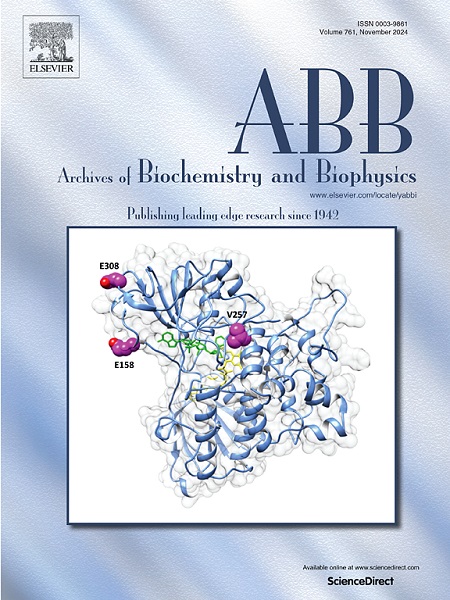九头蛇ADAR的系统发育与结构分析。
IF 3.8
3区 生物学
Q2 BIOCHEMISTRY & MOLECULAR BIOLOGY
引用次数: 0
摘要
作用于RNA的腺苷脱氨酶(ADARs)执行腺苷-肌苷(A-to-I) RNA编辑,具有重要的生物学功能。虽然对多种动物的编辑位点的研究已经揭示了ADAR编辑的独特生物学作用,包括温度适应和生殖成熟,但缺乏对这些ADAR的严格生化和结构研究。本文通过系统发育序列分析和AlphaFold计算结构预测,揭示了水母动物ADAR2s含有5个dsRNA结合域(dsrbd),其中dsrbd和脱氨酶结构域的RNA结合残基是保守的。此外,我们确定了水母动物(如水螅)和花刺动物亚门之间的进化分歧。珊瑚虫ADAR脱氨酶结构域与人类ADAR更接近,具有更长的5' RNA结合环、谷氨酸碱基翻转残基和保守的TWDG二聚化基序。相反,水母动物的ADAR脱氨酶结构域具有短的5'结合环、谷氨酰胺翻转残基和非保守的螺旋二聚化基序。我们还报道了淡水刺胞动物Hydra vulgaris (hyADAR)的ADAR同源物直接检测到A-to-I RNA编辑。我们将hyADAR的单体脱氨酶结构域(hyADARd)的晶体结构求解到2.0 Å分辨率,显示出保守的活性位点结构和已知ADAR活性所需的埋藏肌醇己基磷酸的存在。此外,这些数据表明,水母动物已经进化出新的ADAR结构特征,然而,这一生理后果尚不清楚。此外,这些结果为从进化上遥远的生物中描述ADAR的生化和结构特征提供了一个框架,以了解ADAR编辑在后生动物中的不同作用。本文章由计算机程序翻译,如有差异,请以英文原文为准。

Phylogenetic and structural analysis of Hydra ADAR
Adenosine deaminases acting on RNAs (ADARs) perform adenosine-to-inosine (A-to-I) RNA editing for essential biological functions. While studies of editing sites in diverse animals have revealed unique biological roles of ADAR editing including temperature adaptation and reproductive maturation, rigorous biochemical and structural studies of these ADARs are lacking. Here, we present a phylogenetic sequence analysis and AlphaFold computational structure prediction to reveal that medusozoan ADAR2s contain five dsRNA binding domains (dsRBDs) with several RNA binding residues in the dsRBDs and deaminase domain conserved. Additionally, we identified evolutionary divergence between the medusozoan (e.g. Hydra) and anthozoan cnidarian subphyla. The anthozoan ADAR deaminase domains more closely resemble human ADARs with longer 5′ RNA binding loops, glutamate base-flipping residues, and a conserved TWDG dimerization motif. Conversely, medusozoan ADAR deaminase domains have short 5’ binding loops, glutamine flipping residues, and non-conserved helix dimerization motif. We also report the direct detection of A-to-I RNA editing by an ADAR ortholog from the freshwater cnidarian Hydra vulgaris (hyADAR). We solved the crystal structure of the monomeric deaminase domain of hyADAR (hyADARd) to 2.0 Å resolution, showing conserved active site architecture and the presence of a buried inositol hexakisphosphate known to be required for ADAR activity. In addition, these data demonstrate that medusozoans have evolved novel ADAR structural features, however the physiological consequence of this remains unknown. In addition, these results provide a framework for biochemically and structurally characterizing ADARs from evolutionarily distant organisms to understand the diverse roles of ADAR editing amongst metazoans.
求助全文
通过发布文献求助,成功后即可免费获取论文全文。
去求助
来源期刊

Archives of biochemistry and biophysics
生物-生化与分子生物学
CiteScore
7.40
自引率
0.00%
发文量
245
审稿时长
26 days
期刊介绍:
Archives of Biochemistry and Biophysics publishes quality original articles and reviews in the developing areas of biochemistry and biophysics.
Research Areas Include:
• Enzyme and protein structure, function, regulation. Folding, turnover, and post-translational processing
• Biological oxidations, free radical reactions, redox signaling, oxygenases, P450 reactions
• Signal transduction, receptors, membrane transport, intracellular signals. Cellular and integrated metabolism.
 求助内容:
求助内容: 应助结果提醒方式:
应助结果提醒方式:


